
Siem Reap
Located the northwest of Cambodia about 300km from Pnom Penh capital, Siem Reap is an invaluable world’s cultural heritage recognized by UNESCO in 1992. This site has preserved ruins of the ancient Khmer Empire with the mysterious Angkor architectural ensemble. The number of international visitors to Siem Reap accounts for about 85% the one to Cambodia per year.
- Location: In northwestern Cambodia
- Status: The gateway to Angkor region.
- Population: 174,265
- Religions: Theravada Buddhism
- The popular tourist destination in Cambodia
- Many forms of varied entertainment
Located the northwest of Cambodia about 300km from Pnom Penh capital, Siem Reap is an invaluable world’s cultural heritage recognized by UNESCO in 1992. This site has preserved ruins of the ancient Khmer Empire with the mysterious Angkor architectural ensemble.
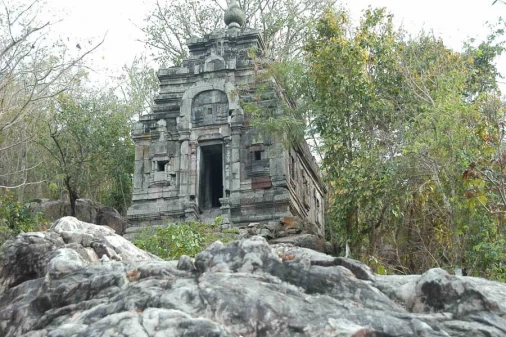
Angkor Borei
Angkor Borei is a town in the area of several ruins and archaeological digs. The area contains artifacts...
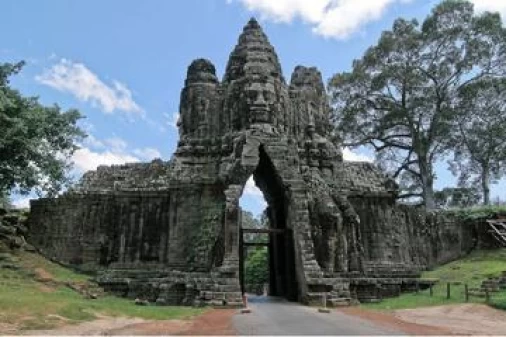
Angkor Thom
The Great City or Capital Angkor derives from Sanskrit word: “Nagara” meaning “City or Town or Capital”;...
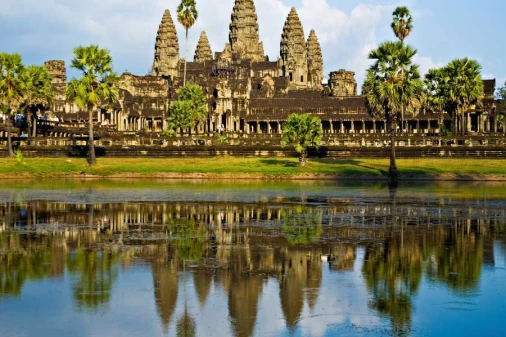
Angkor Wat
The traveller’s first glimpse of Angkor Wat, the ultimate expression of Khmer genius, is matched by...
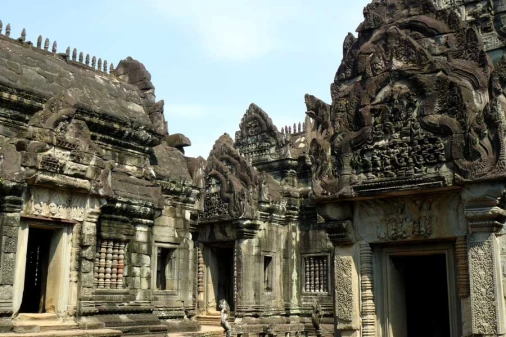
Banteay Sam Re
Banteay Sam Re located at Preah Dak commune, Bon Tiey Srey District by Charles De Gaulle Road via Angkor...
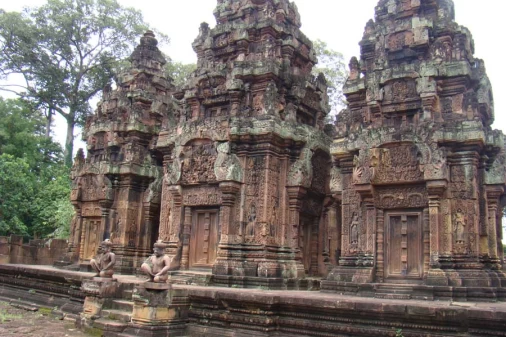
Banteay Srei Temple
Considered by many to be the jewel in the crown of Angkorian art, Banteay Srei is cut from stone of...
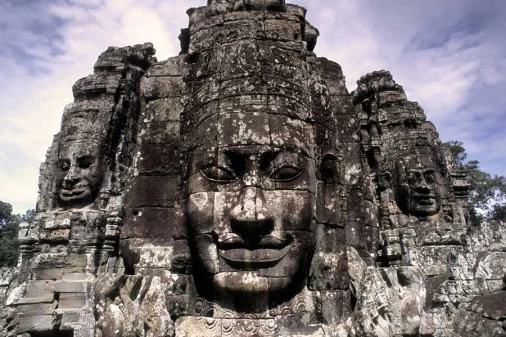
Bayon Temple
At the heart of Angkor Thom is the 12th-century Bayon, the mesmerising, if slightly mind-bending, state...
Frequently asked questions
With an extraordinary fusion of splendor and historical elegance, Siem Reap is undeniably one of the most sought-after destinations not only in Cambodia but across Asia. Whether you are looking for things to do in Siem Reap on a budget or you want to indulge yourself and experience its thriving contemporary culture, every corner of this lovely city can satisfy the heart of every traveler. Among all the Siem Reap tourist attractions you can visit, one thing you shouldn’t forget is the breathtaking collection of UNESCO World Heritage ancient ruins and temples!
Angkor Wat and nearby temples day tour
1-Angkor Wat
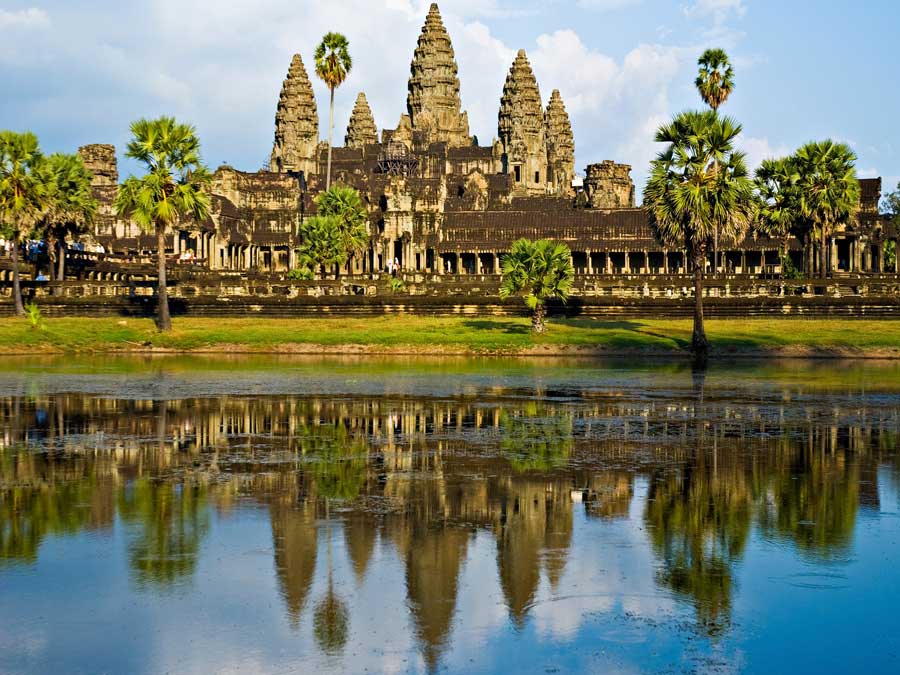
The temples at Angkor are famous in their own rights, even if the status of Angkor Wat as the world’s greatest temple means that it’s the first in most people’s minds. This tour takes in many of the greatest temples in the world, with a knowledgeable, passionate Khmer guide who will enrich your time among our cultural treasures. With the convenience of collection from your hotel by our air-conditioned minivan and chilled water provided, this tour will create memories that last forever.
2-Angkor Wat Sunrise
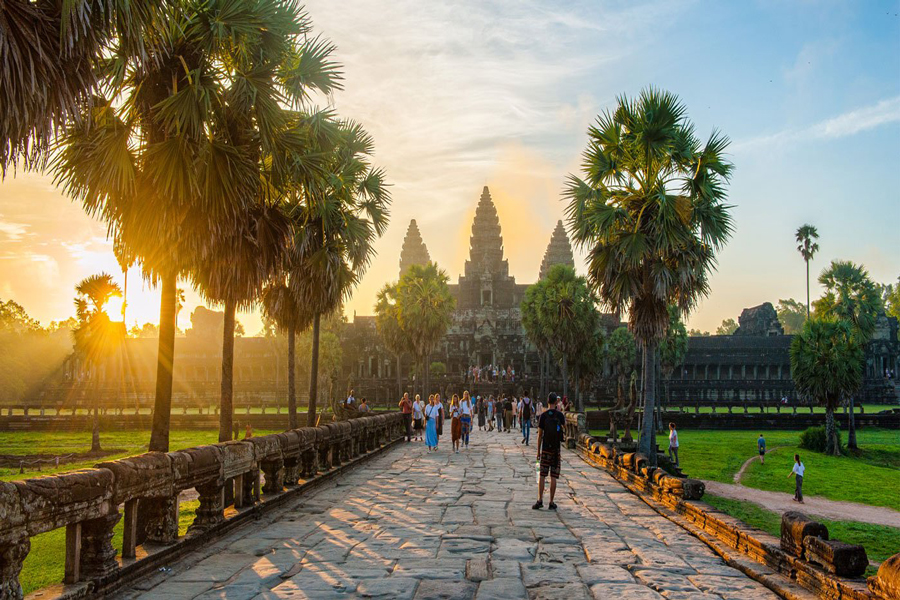 There are a lot of ways to welcome a new day, but what could be more memorable than witnessing the sunrise along with a breathtaking view of an ancient Cambodian complex? Tucked deep inside the tropical forest of the country, Angkor Wat is the former capital of the expansive Khmer Empire. As time goes by, the abandoned ancient city was slowly overgrown by nature. As you stand in one of its halls, you will be energized by the refreshing morning breeze and lifting fogs as it blows through the complex. Witness how the sunrise transforms the surroundings into a dramatic landscape. After that, you’ll visit the richly-decorated temple of Bayon. Believed to be built in the late 12th or early 13th century as the state temple of the Mahayana Buddhist King Jayavarman VII, Bayon stands at the center of Angkor Thom. A day of exploring these tourist sites will surely make you hungry. So have your delicious and filling lunch while looking at the calming views of the countryside. Wrap up the tour by visiting a local village where you can learn more about the vibrant culture of the Cambodians.
There are a lot of ways to welcome a new day, but what could be more memorable than witnessing the sunrise along with a breathtaking view of an ancient Cambodian complex? Tucked deep inside the tropical forest of the country, Angkor Wat is the former capital of the expansive Khmer Empire. As time goes by, the abandoned ancient city was slowly overgrown by nature. As you stand in one of its halls, you will be energized by the refreshing morning breeze and lifting fogs as it blows through the complex. Witness how the sunrise transforms the surroundings into a dramatic landscape. After that, you’ll visit the richly-decorated temple of Bayon. Believed to be built in the late 12th or early 13th century as the state temple of the Mahayana Buddhist King Jayavarman VII, Bayon stands at the center of Angkor Thom. A day of exploring these tourist sites will surely make you hungry. So have your delicious and filling lunch while looking at the calming views of the countryside. Wrap up the tour by visiting a local village where you can learn more about the vibrant culture of the Cambodians.
3- Bayon
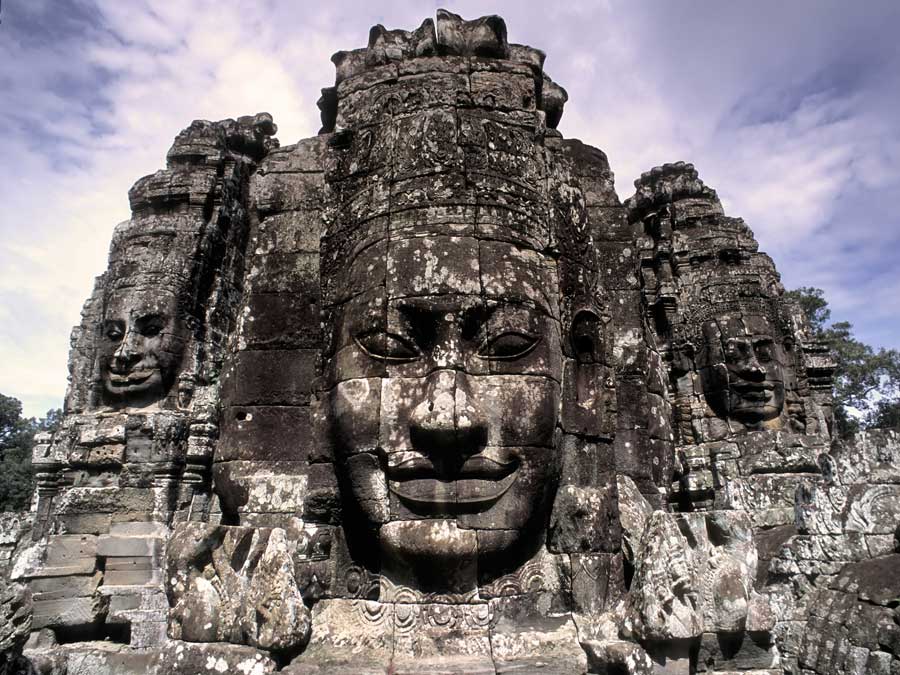 Learn more about Cambodia’s royal past when you visit Angkor, the city that was once the seat of Khmer political power. See the well-preserved ruins of this ancient city in this 2 day private tour and get your own personal tuk-tuk service. Not just that, but your tour’s flexible itinerary schedule will allow you to enjoy every stop to the fullest. Take unlimited photos from the comfort of your tuk-tuk ride and get to one destination to another without breaking a sweat. To know the city’s history better, book an English-speaking guide upon checkout. Let your guide talk you through the tour and experience a truly immersive 2 day private journey. See the impressive carvings at South Gate of Angkor Thom, climb up the temple mountains of Baphoun and Phimeanakas Temple, marvel at the extensive bas reliefs of Bayon Temple and the Terrace of the Elephants, visit the architectural marvel that is Angkor Wat, and watch woodworking, stone carving and polychrome training in real time at Artisans Angkor. End the tour with a ride back to your hotel
Learn more about Cambodia’s royal past when you visit Angkor, the city that was once the seat of Khmer political power. See the well-preserved ruins of this ancient city in this 2 day private tour and get your own personal tuk-tuk service. Not just that, but your tour’s flexible itinerary schedule will allow you to enjoy every stop to the fullest. Take unlimited photos from the comfort of your tuk-tuk ride and get to one destination to another without breaking a sweat. To know the city’s history better, book an English-speaking guide upon checkout. Let your guide talk you through the tour and experience a truly immersive 2 day private journey. See the impressive carvings at South Gate of Angkor Thom, climb up the temple mountains of Baphoun and Phimeanakas Temple, marvel at the extensive bas reliefs of Bayon Temple and the Terrace of the Elephants, visit the architectural marvel that is Angkor Wat, and watch woodworking, stone carving and polychrome training in real time at Artisans Angkor. End the tour with a ride back to your hotel
4- Angkor Thom
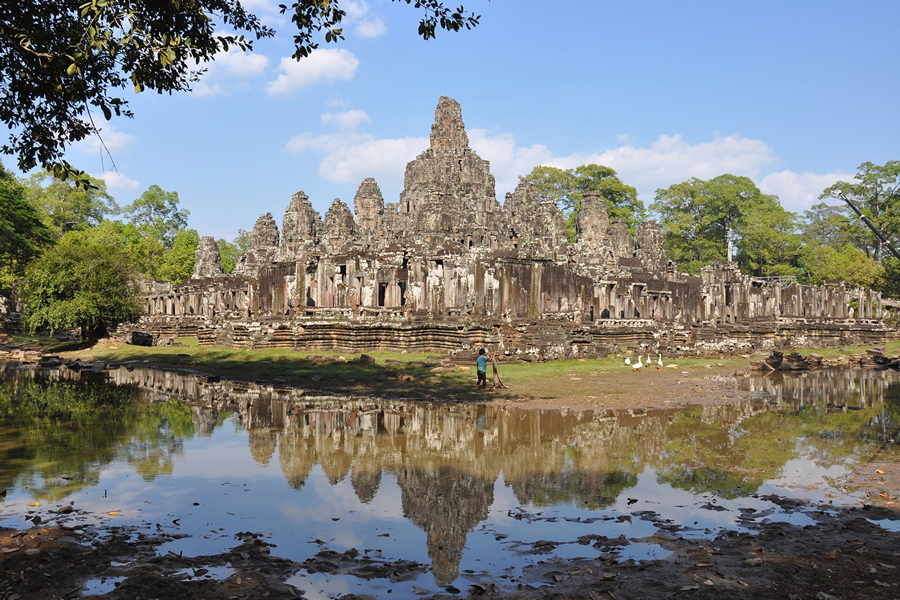 Looking for another way to experience the majestic beauty of Angkor Wat? Then, you’re in luck! Book this afternoon private tour that will bring you to the iconic ancient city. Start with a pick up from your hotel in Siem Reap at least four hours before the sun sets. Enjoy the relaxing view of the countryside as your jeep takes the road that passes through the lush green rice paddies. Take a relaxing stroll around Angkor Park with your guide and learn about the complex’s rich history and cultural significance. Finally, end the fantastic afternoon by taking in the stunning sunset over the ancient city of Angkor Wat. Get a truly magical experience as the sun begins to set and the sky turns into shades of orange, pink and purple. Witness an amazing transition of over 50 statues lined up and decorating Angkor Thom as you cruise the surrounding lake inside the park. Don’t forget to bring a camera with you to capture picturesque and Instagram-worthy shots during this tour.
Looking for another way to experience the majestic beauty of Angkor Wat? Then, you’re in luck! Book this afternoon private tour that will bring you to the iconic ancient city. Start with a pick up from your hotel in Siem Reap at least four hours before the sun sets. Enjoy the relaxing view of the countryside as your jeep takes the road that passes through the lush green rice paddies. Take a relaxing stroll around Angkor Park with your guide and learn about the complex’s rich history and cultural significance. Finally, end the fantastic afternoon by taking in the stunning sunset over the ancient city of Angkor Wat. Get a truly magical experience as the sun begins to set and the sky turns into shades of orange, pink and purple. Witness an amazing transition of over 50 statues lined up and decorating Angkor Thom as you cruise the surrounding lake inside the park. Don’t forget to bring a camera with you to capture picturesque and Instagram-worthy shots during this tour.
5-Banteay Srei
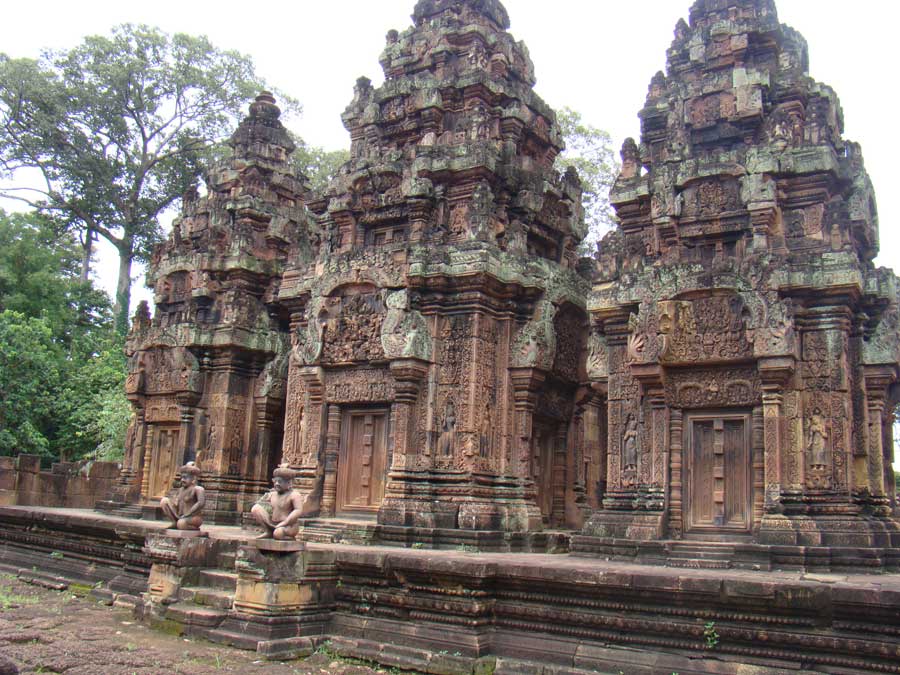 Explore some of Siem Reap’s temples that lie off the beaten tourist path on this one-day tour that takes you to five different temples! Choose between a join in or private tour depending on what suits your preferences. Start your tour off with a stop at Pre Rup, whose brick and laterite materials are emphasized by the light of the morning sun. This is followed by a visit to the Banteay Srei Temple, or the “Citadel of Women”, believed to have been made by a woman as the carvings are thought to be too elaborate for the hand of men. Take a break and reenergize yourself with a meal at a local restaurant, where you can savor traditional Cambodian curries, soups and stir-fries at your own expense. See finely-carved sculptures at the East Mebon Temple, with a variety of structures such as stone elephants and lions, and Ta Som Temple, with four faces of Avalokiteshvara on the well-preserved towers. The tour ends with a stroll around Preah Khan Temple, filled with vaulted corridors, fine carvings and delicate stonework, right before you head back to your hotel.
Explore some of Siem Reap’s temples that lie off the beaten tourist path on this one-day tour that takes you to five different temples! Choose between a join in or private tour depending on what suits your preferences. Start your tour off with a stop at Pre Rup, whose brick and laterite materials are emphasized by the light of the morning sun. This is followed by a visit to the Banteay Srei Temple, or the “Citadel of Women”, believed to have been made by a woman as the carvings are thought to be too elaborate for the hand of men. Take a break and reenergize yourself with a meal at a local restaurant, where you can savor traditional Cambodian curries, soups and stir-fries at your own expense. See finely-carved sculptures at the East Mebon Temple, with a variety of structures such as stone elephants and lions, and Ta Som Temple, with four faces of Avalokiteshvara on the well-preserved towers. The tour ends with a stroll around Preah Khan Temple, filled with vaulted corridors, fine carvings and delicate stonework, right before you head back to your hotel.
6-Preah Khan
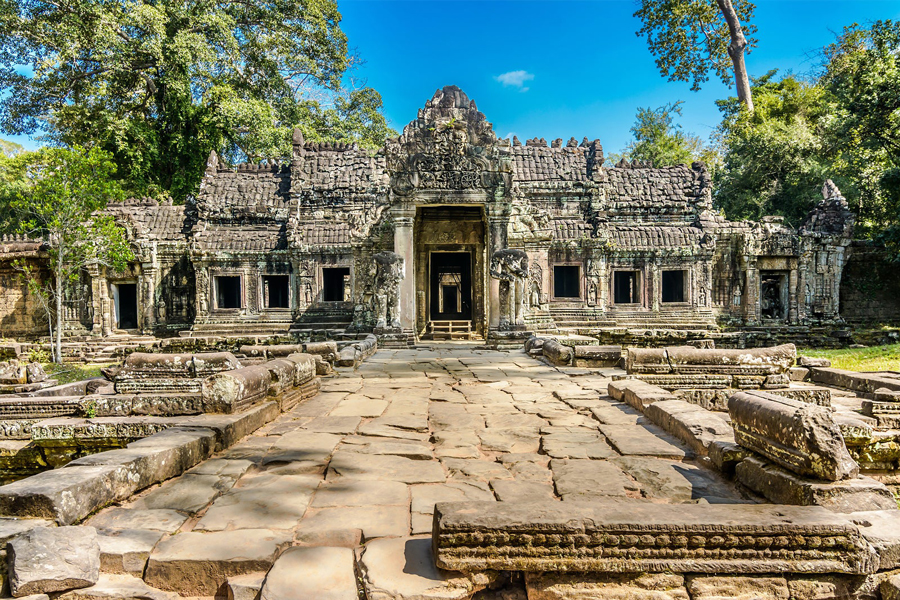 Enjoy a unique, one-of-a-kind experience during your trip to Cambodia and discover the sophisticated architecture of the Khmer Empire with this daytime exploration of Siem Reap by tuk-tuk. In the morning, you’ll get picked up at your hotel in the city, followed by a quick trip to the ticket station to purchase your Angkor Passes. Once everything’s all set, hop on your very own tuk-tuk, which can seat up to a maximum of 4 persons, and begin the tour! Proceed to the first stop of the day, Preah Khan Temple, which was dedicated by the great king Jayavarman VII to his father. Marvel at the wonders of the Neak Pean Temple, a small temple built on top of an artificial island, and the Eastern Mebon Temple, which used to be completely surrounded by water and accessible only via boat. Take a quick break for lunch at a nearby restaurant, at your own expense, make your way to Ta Som Temple, with its well-preserved entrance gopuras that depict Avalokiteshvara, the Bodhisattva of compassion. Head to Pre Rup Temple, a popular destination for sunset watching, believed to have served as an early crematorium for the royals. Your last stop for the day is Srah Srang Lak, a large pond on the Eastern side of Angkor Thom that was used for ritual washings, which is still filled with water until today! If you wish to do a bit more sightseeing, you can also choose to visit either Banteay Srei Temple ot the Kbal Spean, before you get dropped off back at your hotel.
Enjoy a unique, one-of-a-kind experience during your trip to Cambodia and discover the sophisticated architecture of the Khmer Empire with this daytime exploration of Siem Reap by tuk-tuk. In the morning, you’ll get picked up at your hotel in the city, followed by a quick trip to the ticket station to purchase your Angkor Passes. Once everything’s all set, hop on your very own tuk-tuk, which can seat up to a maximum of 4 persons, and begin the tour! Proceed to the first stop of the day, Preah Khan Temple, which was dedicated by the great king Jayavarman VII to his father. Marvel at the wonders of the Neak Pean Temple, a small temple built on top of an artificial island, and the Eastern Mebon Temple, which used to be completely surrounded by water and accessible only via boat. Take a quick break for lunch at a nearby restaurant, at your own expense, make your way to Ta Som Temple, with its well-preserved entrance gopuras that depict Avalokiteshvara, the Bodhisattva of compassion. Head to Pre Rup Temple, a popular destination for sunset watching, believed to have served as an early crematorium for the royals. Your last stop for the day is Srah Srang Lak, a large pond on the Eastern side of Angkor Thom that was used for ritual washings, which is still filled with water until today! If you wish to do a bit more sightseeing, you can also choose to visit either Banteay Srei Temple ot the Kbal Spean, before you get dropped off back at your hotel.
7- Baphuon
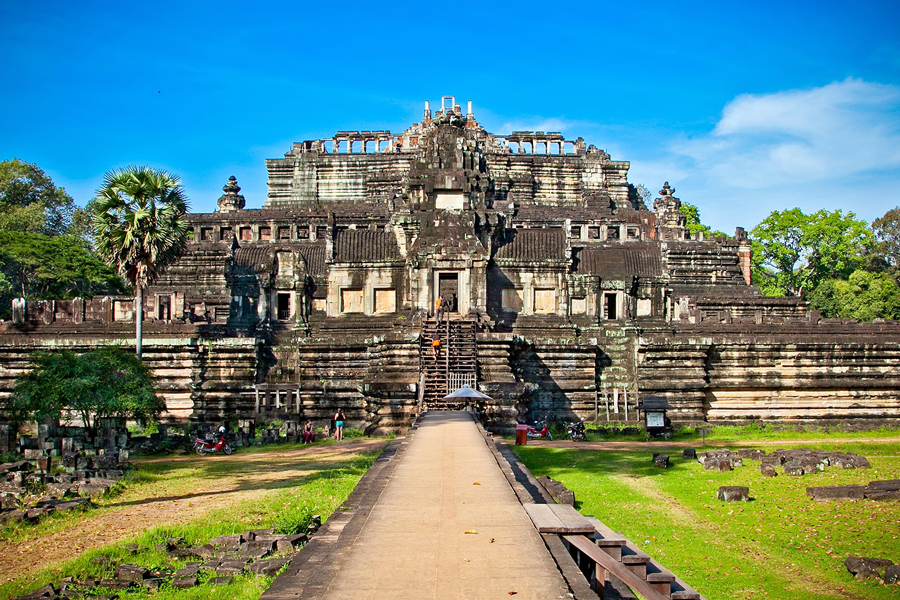 Experience Cambodia in a completely different way by exploring the temples of Angkor Small Circuit while you’re inside a Tuk-Tuk! Known as one of the most iconic symbols of Siem Reap, the Tuk-Tuk, which can fit groups of up to 4 persons, is a must-try for anyone looking to immerse themselves in the city’s rich and vibrant cultures. The Angkor Temples tour will start in the morning – you’ll get picked up at your hotel, then proceed to the ticket station to purchase your Angkor Passes. Once you’re done, hop on the Tuk-tuk and head to the first stop of the tour, the majestic Angkor Wat, the largest religious monument in the entire world. Marvel at its stunning architecture, with tall towers akin to a flowering lotus bud. Make your way to Angkor Thom and Bayon Temple, surrounded by lush forests and best seen in the morning due to its eastward orientation, before you take a quick break for lunch at a local restaurant, at your own expense. Climb up the Terrace of the Elephants, a 300-meter long platform which was used by King Jayavarman VII to follow games and celebrations, as well as watch his armies return from victory. Check out the architectural beauty and sound designs of the Ta Keo Temple, said to have been left incomplete due to a bad omen after a lightning bolt hit it during construction, and the Ta Prohm Temple, used as a filming location for the movie Tomb Raider. Your last stop for the Angkor Tuk Tuk tour is the Banteay Kdei Temple, which has been overtaken by the vegetation surrounding it, before you head back to the city and get dropped off at your hotel/accommodation.
Experience Cambodia in a completely different way by exploring the temples of Angkor Small Circuit while you’re inside a Tuk-Tuk! Known as one of the most iconic symbols of Siem Reap, the Tuk-Tuk, which can fit groups of up to 4 persons, is a must-try for anyone looking to immerse themselves in the city’s rich and vibrant cultures. The Angkor Temples tour will start in the morning – you’ll get picked up at your hotel, then proceed to the ticket station to purchase your Angkor Passes. Once you’re done, hop on the Tuk-tuk and head to the first stop of the tour, the majestic Angkor Wat, the largest religious monument in the entire world. Marvel at its stunning architecture, with tall towers akin to a flowering lotus bud. Make your way to Angkor Thom and Bayon Temple, surrounded by lush forests and best seen in the morning due to its eastward orientation, before you take a quick break for lunch at a local restaurant, at your own expense. Climb up the Terrace of the Elephants, a 300-meter long platform which was used by King Jayavarman VII to follow games and celebrations, as well as watch his armies return from victory. Check out the architectural beauty and sound designs of the Ta Keo Temple, said to have been left incomplete due to a bad omen after a lightning bolt hit it during construction, and the Ta Prohm Temple, used as a filming location for the movie Tomb Raider. Your last stop for the Angkor Tuk Tuk tour is the Banteay Kdei Temple, which has been overtaken by the vegetation surrounding it, before you head back to the city and get dropped off at your hotel/accommodation.
8- Pre Rup
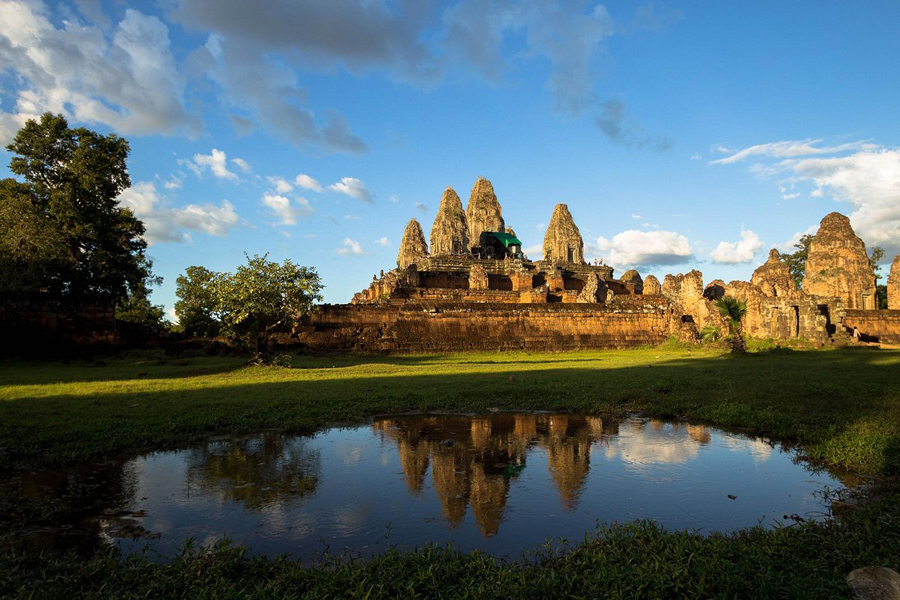 Discover Cambodia’s ancient times in this private 3-day tour of Angkor! For 3 days, you’ll get to see the monuments and temples that reflected Angkor’s sophistication as a kingdom in ancient Southeast Asia. Once the seat of political power, Angkor’s extensive temple complex housed Khmer royals for centuries. Visit these heritage sites and see the glorious ruins of the city on a tuk-tuk, a charming transportation at your service throughout the tour. Hear the origin story of every attraction from your English-speaking guide (available to book upon checkout) for a truly educational and immersive 3-day tour. On your first day, you’ll get to visit Neak Pean, Ta Som, East Mebon, and Pre Rup Temple. The next day you’ll be touring the architectural marvel and icon that is Angkor Wat, where you’ll continue on to Ta Prohm Temple, the iconic set of Tomb Raider. On the same day, you’ll visit Angkor Thom’s Bayon Temple, Baphoun Temple, Pimeanakas Temple, and the Terrace of the Elephants. For your final day, your tour will take you to Banteay Srey Temple for a final glimpse into Angkor’s past. Drop by Psar Chaa – Old Market for some souvenir shopping. See all these sights and more when you book through Klook!
Discover Cambodia’s ancient times in this private 3-day tour of Angkor! For 3 days, you’ll get to see the monuments and temples that reflected Angkor’s sophistication as a kingdom in ancient Southeast Asia. Once the seat of political power, Angkor’s extensive temple complex housed Khmer royals for centuries. Visit these heritage sites and see the glorious ruins of the city on a tuk-tuk, a charming transportation at your service throughout the tour. Hear the origin story of every attraction from your English-speaking guide (available to book upon checkout) for a truly educational and immersive 3-day tour. On your first day, you’ll get to visit Neak Pean, Ta Som, East Mebon, and Pre Rup Temple. The next day you’ll be touring the architectural marvel and icon that is Angkor Wat, where you’ll continue on to Ta Prohm Temple, the iconic set of Tomb Raider. On the same day, you’ll visit Angkor Thom’s Bayon Temple, Baphoun Temple, Pimeanakas Temple, and the Terrace of the Elephants. For your final day, your tour will take you to Banteay Srey Temple for a final glimpse into Angkor’s past. Drop by Psar Chaa – Old Market for some souvenir shopping. See all these sights and more when you book through Klook!
9- Terrace of Elephants
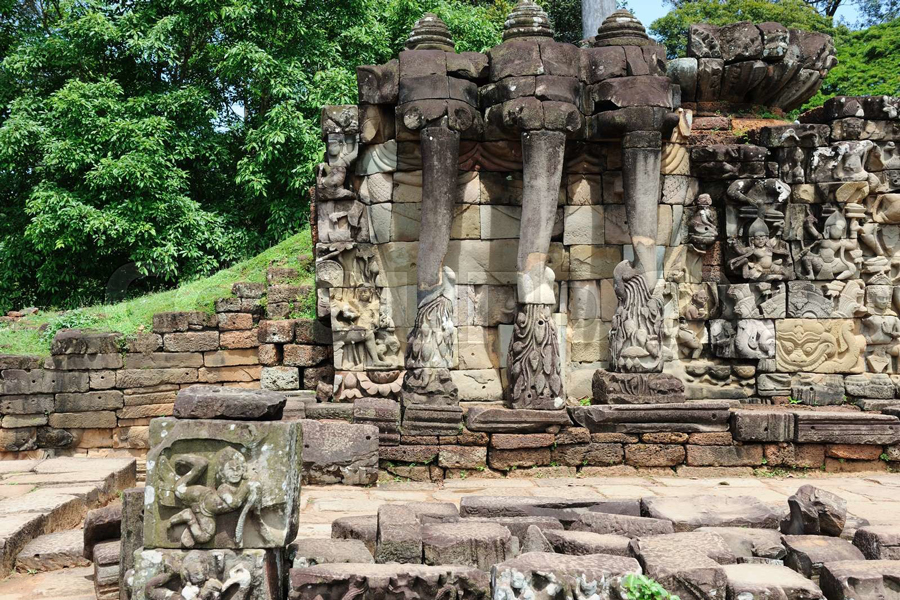 Known as one of the most iconic symbols of Siem Reap, the Tuk-Tuk, which can fit groups of up to 4 persons, is a must-try for anyone looking to immerse themselves in the city’s rich and vibrant cultures. Discover Cambodia from a completely new perspective as you roam around the Small Circuit, drinking up up the gorgeous view of the sunrise at Angkor Wat and basking in the setting sun at the Banteay Kdey Temple. Get picked up early in the morning at your hotel In the morning, then proceed to the ticket station to purchase your Angkor Passes. Once that’s all settled, hop on your private Tuk-tuk and head to the first stop of the tour, the majestic Angkor Wat. Known as the largest religious monument in the entire world, you’ll get to witness the marvelous sight of the sun rising above the temple, painting its tall towers akin to a flowering lotus bud a variety of colors. Make your way to Angkor Thom and Bayon Temple, surrounded by lush forests and best seen in the morning due to its eastward orientation, then climb up the Terrace of the Elephants, a long platform used by King Jayavarman VII to follow games and celebrations, as well as watch his armies return from victory. Take a quick break for lunch to rest and recharge, at your own expense, then travel up Ta Keo Temple, perched on top of a mountain and rumored to have been left incomplete due to a bad omen after it was hit by a lightning bolt during its construction. Your last stops for the tour are Ta Prohm Temple, used as a filming location for the movie Tomb Raider and the Banteay Kdei Temple, overtaken by the lush vegetation surrounding it, before you head back to the city and get dropped off at your hotel/accommodation.
Known as one of the most iconic symbols of Siem Reap, the Tuk-Tuk, which can fit groups of up to 4 persons, is a must-try for anyone looking to immerse themselves in the city’s rich and vibrant cultures. Discover Cambodia from a completely new perspective as you roam around the Small Circuit, drinking up up the gorgeous view of the sunrise at Angkor Wat and basking in the setting sun at the Banteay Kdey Temple. Get picked up early in the morning at your hotel In the morning, then proceed to the ticket station to purchase your Angkor Passes. Once that’s all settled, hop on your private Tuk-tuk and head to the first stop of the tour, the majestic Angkor Wat. Known as the largest religious monument in the entire world, you’ll get to witness the marvelous sight of the sun rising above the temple, painting its tall towers akin to a flowering lotus bud a variety of colors. Make your way to Angkor Thom and Bayon Temple, surrounded by lush forests and best seen in the morning due to its eastward orientation, then climb up the Terrace of the Elephants, a long platform used by King Jayavarman VII to follow games and celebrations, as well as watch his armies return from victory. Take a quick break for lunch to rest and recharge, at your own expense, then travel up Ta Keo Temple, perched on top of a mountain and rumored to have been left incomplete due to a bad omen after it was hit by a lightning bolt during its construction. Your last stops for the tour are Ta Prohm Temple, used as a filming location for the movie Tomb Raider and the Banteay Kdei Temple, overtaken by the lush vegetation surrounding it, before you head back to the city and get dropped off at your hotel/accommodation.
Day 1: Arrive in Siem Reap
 Upon arrival, you will be met outside the baggage claim area by your guide who will escort you to a waiting vehicle for your transfer to downtown with a brief introduction en route. Your guide will be holding a welcome signboard with the Asia Tour Advisor Logo & your name. During the drive your guide will provide an introduction to Siem Reap.
Upon arrival, you will be met outside the baggage claim area by your guide who will escort you to a waiting vehicle for your transfer to downtown with a brief introduction en route. Your guide will be holding a welcome signboard with the Asia Tour Advisor Logo & your name. During the drive your guide will provide an introduction to Siem Reap.
Siem Reap, situated in the north west of the country, is an enchanting town with Chinese-style shop houses, French colonial architecture and tree lined boulevards. It is the gateway to the World Heritage ancient temple ruins of Angkor, eighth wonder of the world and spectacular ancient capital of the powerful Khmer Dynasty. As well as the myriad of awe-inspiring temples and Khmer relics to explore, Siem Reap and its rural outskirts offers craft villages, silk farms, Khmer cuisine cooking classes, traditional Cambodian “apsara” dance performances and the floating villages on the tranquil waters of Tonle Sap Lake.
Day 2: Siem Reap Tour
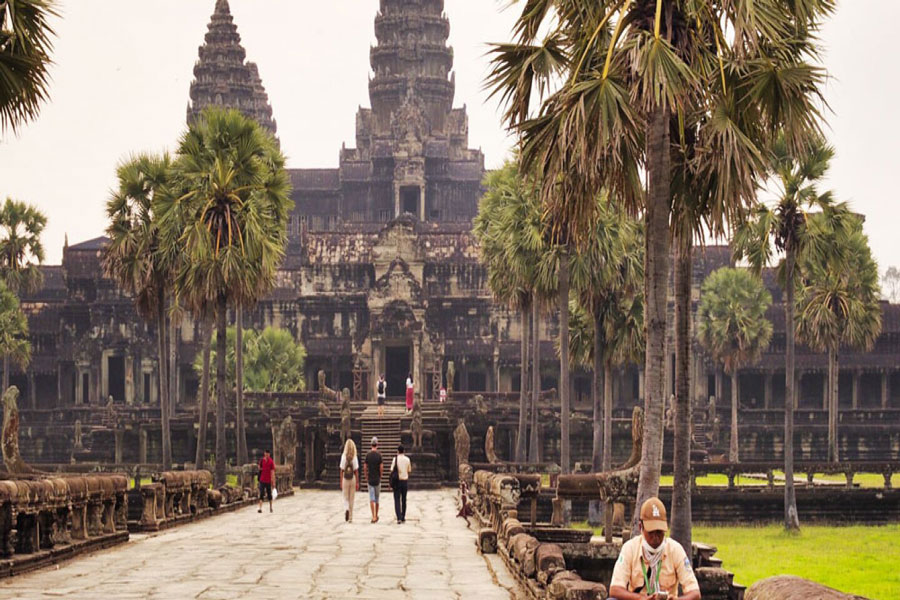 Artisans d’Angkor focuses on training unschooled rural youth in traditional handicraft skills. Here you can discover traditional Cambodian handicraft skills and observe the artisans at work. Ancient techniques are still practiced here such as wood and stone carving, lacquering, gilding and silk painting. A guided tour will provide you with more insight into this organization and you may direct any questions to one of the artisans through your guide.
Artisans d’Angkor focuses on training unschooled rural youth in traditional handicraft skills. Here you can discover traditional Cambodian handicraft skills and observe the artisans at work. Ancient techniques are still practiced here such as wood and stone carving, lacquering, gilding and silk painting. A guided tour will provide you with more insight into this organization and you may direct any questions to one of the artisans through your guide.
Meet one of the directors from Artisans d’Angkor who will explain about the overall operations and their goals for the future. You will also learn more about the artisans’ backgrounds and how this training has helped them to get a head start in life. And continue to visit to Angkor National Museum, in November 2007, the Angkor National Museum opened its doors, offering a comprehensive collection of Cambodian artifacts showcasing the origins of Khmer art, culture, and architecture.
With eight galleries in total, it covers in depth the history of Cambodia and the Khmer Empire as well as a fascinating collection of Buddhist artifacts. Apart from the antiques and historical relics, they have successfully integrated state-of-the-art multimedia technology to help bring the exhibitions to life.
Day 3: Siem Reap Tour
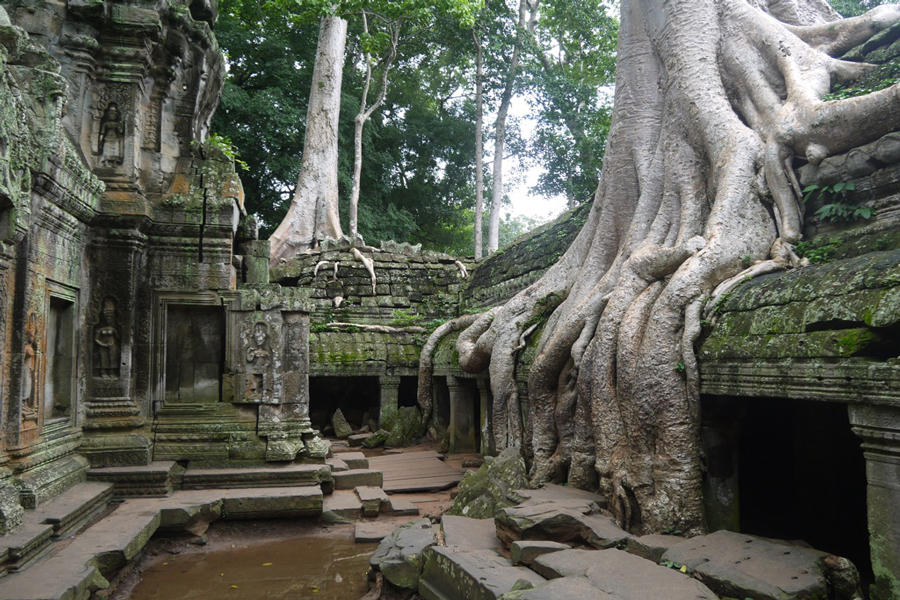 Have an early breakfast at hotel. At 07h30, depart hotel for visit to the picturesque Ta Prohm that had nearly disappeared into the jungle and remains overgrown, an oddly haunting and exotic scene. The magnificent roots of a tree, pushing between the huge stone blocks of the temple in a sort of embrace, evoke feelings that you may remember forever. And continue to visit the intricately carved Khmer ruins at Angkor Wat – one of the world’s most impressive ruins.
Have an early breakfast at hotel. At 07h30, depart hotel for visit to the picturesque Ta Prohm that had nearly disappeared into the jungle and remains overgrown, an oddly haunting and exotic scene. The magnificent roots of a tree, pushing between the huge stone blocks of the temple in a sort of embrace, evoke feelings that you may remember forever. And continue to visit the intricately carved Khmer ruins at Angkor Wat – one of the world’s most impressive ruins.
The temple still owns fine Apsara carvings in Angkorian era art. And continue exploring the mysterious Royal city Angkor Thom. City & Bayon Its 54-tower temple is an awesome sight. At first glance it seems a shapeless mass of stone, but further scrutiny reveals a face, and then another and another until suddenly you are engulfed by the silent, heavy, enigmatic and silent gaze through half-closed eyes, staring out from a primitive and remote time.
Further, visit to the surroundings of the complex including the Baphou, Elephant Terraces, Lipper King Terrace and Royal Palace Enclosure area and visit one more ruin in Angkor Area of Preah Khan temple, built in 12th century by King Jayavarman VII and it is the same style to Ta Prom Temple.
Day 4: Siem Reap – Tonle Sap Lake – Departure
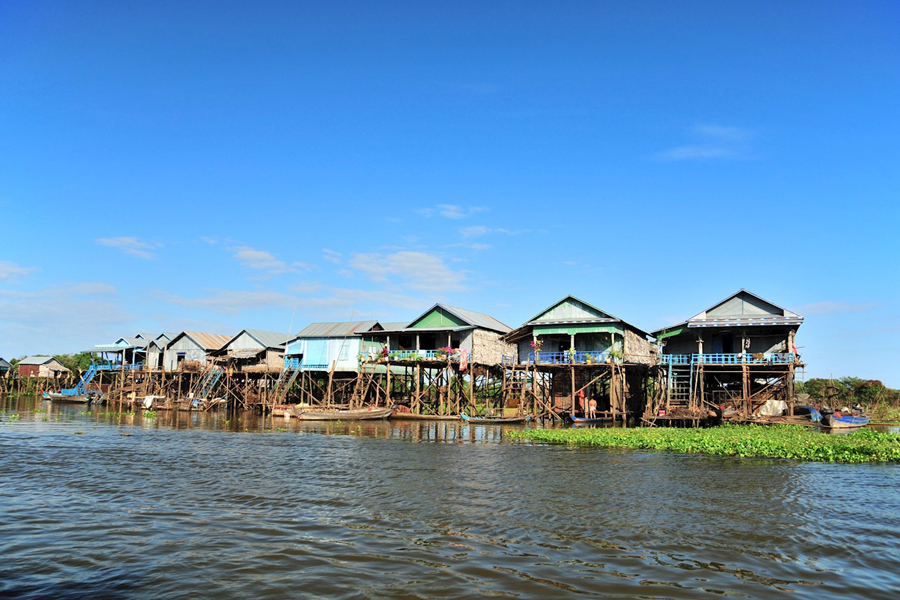 Breakfast at your hotel. Drive to southern party of Siem Reap to embark on a short cruise on Tonle Sap Lake, Cambodia’s biggest natural water body. The experience is wonderful as we pass by floating village, friendly children in small boats and fishermen at work and sunset at Phnom Krom. Then free time until pick you up and take you to the airport for your flight to next destination.
Breakfast at your hotel. Drive to southern party of Siem Reap to embark on a short cruise on Tonle Sap Lake, Cambodia’s biggest natural water body. The experience is wonderful as we pass by floating village, friendly children in small boats and fishermen at work and sunset at Phnom Krom. Then free time until pick you up and take you to the airport for your flight to next destination.
Asia Tour Advisor can arrange additional customized trips for you should you require it.
Finish unforgettable Cambodia Tour with Asia Tour Advisor Co.,. Good bye & see you in the next time! AsiaTourAdvisor can arrange additional customized trips for you if the above itinerary does not match your expectations.
1- Prahok
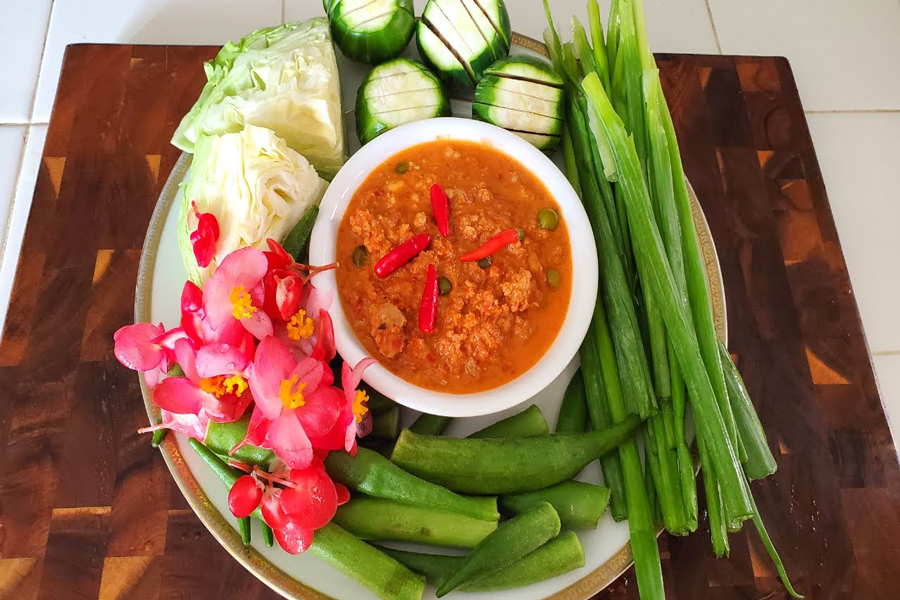 Phahok is a gray paste made of fermented fish. No, it doesn’t sound amazing, but it’s a delicious Cambodian dish that’s unique to the country. It’s made by first exposing the fish to the sun for about a day. This allows for the fish to dry out and begin the fermentation process. After a day, the fish mixed with sugar, garlic, and cold rice. Once everything has been well combined, the Prahok is ready to ferment. The mixture is placed into a jar where it’ll sit for several months before it’s ready.
Phahok is a gray paste made of fermented fish. No, it doesn’t sound amazing, but it’s a delicious Cambodian dish that’s unique to the country. It’s made by first exposing the fish to the sun for about a day. This allows for the fish to dry out and begin the fermentation process. After a day, the fish mixed with sugar, garlic, and cold rice. Once everything has been well combined, the Prahok is ready to ferment. The mixture is placed into a jar where it’ll sit for several months before it’s ready.
Once the prahok is finished it’s used more of as a spice to bring out the flavors in a variety of Cambodian dishes rather than a stand alone dish.
2-Amok Fish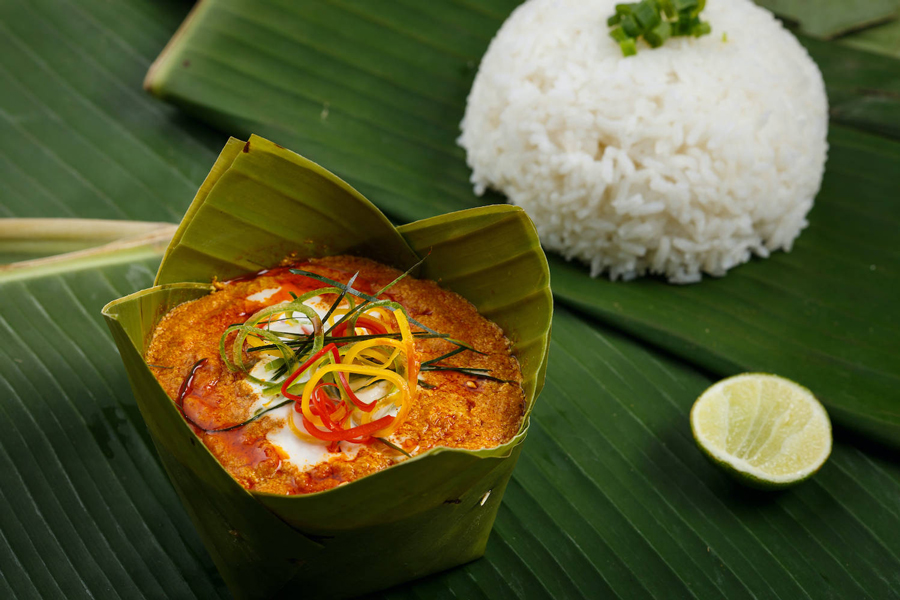 Amok fish is a thick yellow curry made with catfish. It’s typically served in a coconut or wrapped in a banana leaf which gives it a visually appealing appearance.
Amok fish is a thick yellow curry made with catfish. It’s typically served in a coconut or wrapped in a banana leaf which gives it a visually appealing appearance.
Amok on it’s own is simply yellow curry which is often eaten alone. When combined with freshwater catfish it becomes amok fish, as the name suggests. To make this pretty dish, the fish and curry are steamed together with banana leaves which results in a soft, creamy texture. Outside of just fish and curry there are several ingredients which make this dish a Cambodian special you can’t miss. Garlic, salt, prahok, lemongrass, chili paste, coconut milk, and galangal are staple pieces in amok fish which can’t be missed.
Traditionally amok fish is eaten during the winter, but it’s popularity means any visitor is able to find and try this dish in many Cambodian eateries.
Want to try your hand at making Amok Fish? It’s easier that it looks! Cookly has several courses that’ll teach you how to make traditional Siem Reap dishes and Amok Fish like the course below.
3-Lok Lak
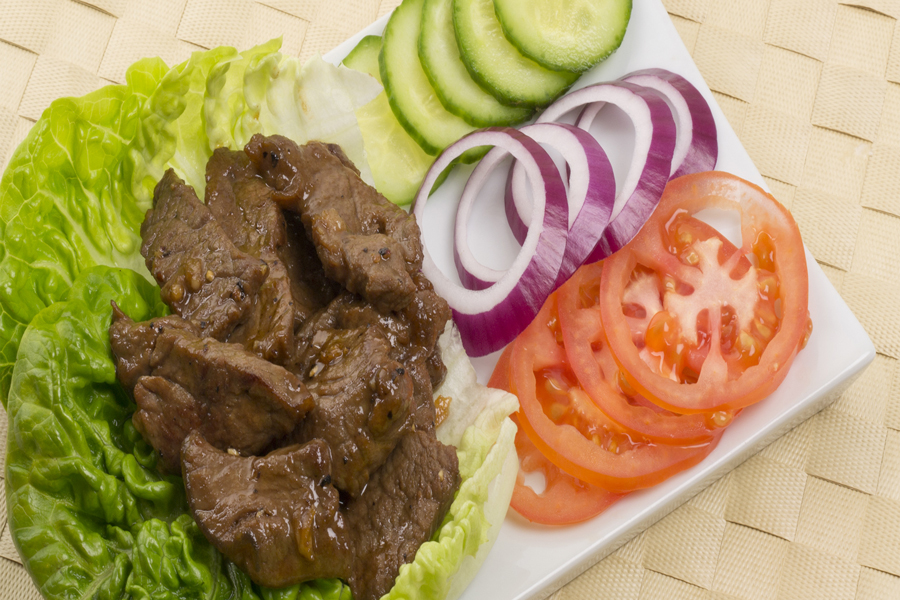 Lok Lak is a savory Cambodian dish you must try on your visit to siem reap. On the surface Lok Lak is simply a stir-fried beef dish, but the secret to this Siem Reap speciality lies within the marinade. The beef is marinated overnight in a mixture of fish sauce, lemon, oyster sauce, and pepper which gives the Lok Lak it’s unique flavor.
Lok Lak is a savory Cambodian dish you must try on your visit to siem reap. On the surface Lok Lak is simply a stir-fried beef dish, but the secret to this Siem Reap speciality lies within the marinade. The beef is marinated overnight in a mixture of fish sauce, lemon, oyster sauce, and pepper which gives the Lok Lak it’s unique flavor.
You’ll most likely see Lok Lak served alongside a bed of lettuce, tomato, red onion, cucumber, rice, brown sauce, and a fried egg. And while it’s most commonly made with beef, many restaurants are willing to switch it out for pork, chicken, or even tofu.
4-Prahok Ktiss
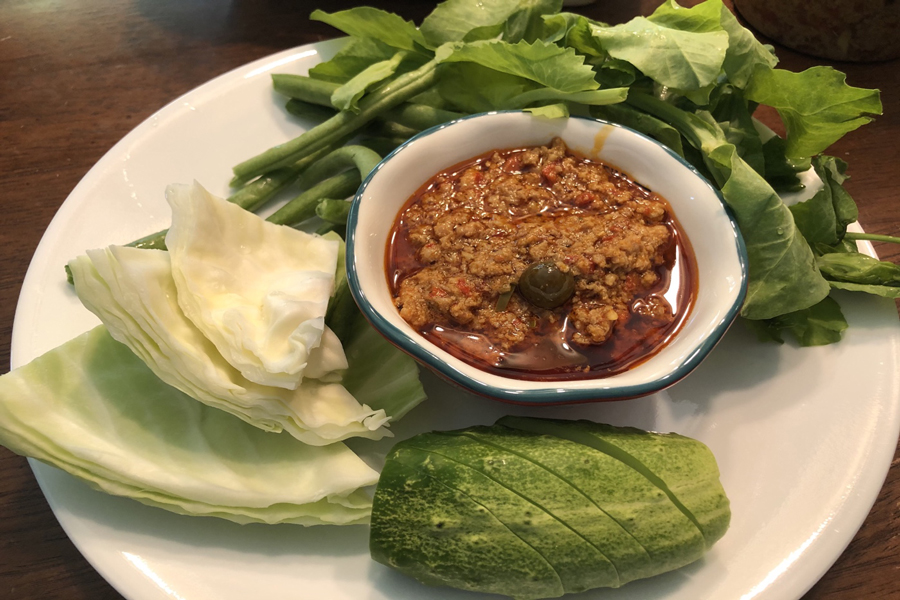 Prahok Ktiss is another traditional Siem Reap condiment. Like prahok, Prahok Ktiss uses fermented fish as its main ingredient; however, it produces a much less intrusive flavor. Many prahok dishes have a pungent flavor, but since Prahok Ktiss is a dipping sauce, the flavor is more tame so it doesn’t over power whatever is being dipped into it.
Prahok Ktiss is another traditional Siem Reap condiment. Like prahok, Prahok Ktiss uses fermented fish as its main ingredient; however, it produces a much less intrusive flavor. Many prahok dishes have a pungent flavor, but since Prahok Ktiss is a dipping sauce, the flavor is more tame so it doesn’t over power whatever is being dipped into it.
The special ingredient which gives Prahok it’s palatable taste is the addition of pork belly or minced pork. This is accompanied by eggplant, coconut milk, and Khmer curry paste (kroeung).
Since Prahok Ktiss is a dipping sauce is primarily enjoyed as a snack. When you order Prahok Ktiss, you’ll see it comes with a variety of sliced veggies like carrot, cabbage, long beans, and cucumber. You can also find it next to rice or noodles as a side dish.
5-Chili Fried Insects
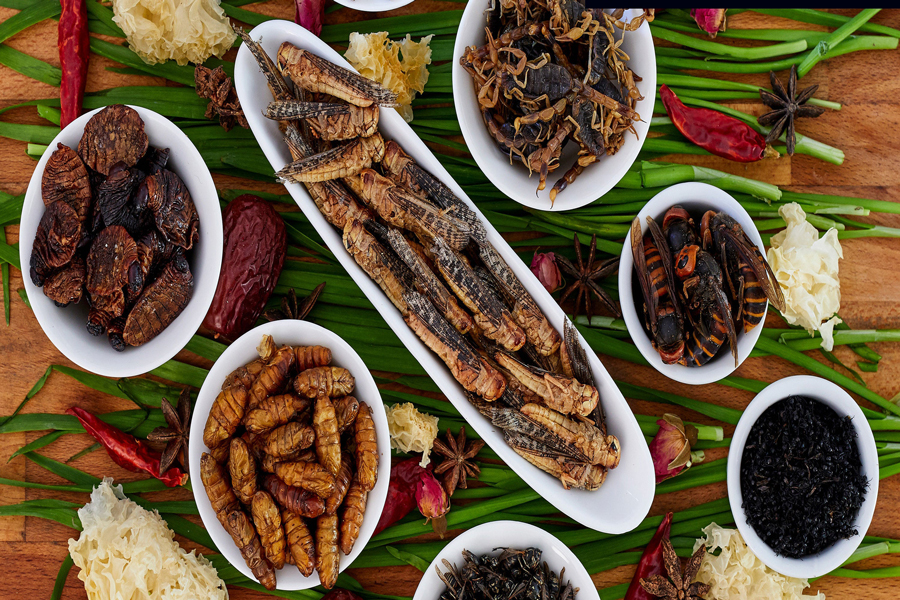 It may not sound appetizing to eat insects on your vacation, but trust us it’s a must-try in Siem Reap. You’ll find while roaming the streets of Siem Reap that it’s quite common to find bugs of all types as snacks eat on the go. The reason for this is due to insects being particularly cheap and packed with nutrition.
It may not sound appetizing to eat insects on your vacation, but trust us it’s a must-try in Siem Reap. You’ll find while roaming the streets of Siem Reap that it’s quite common to find bugs of all types as snacks eat on the go. The reason for this is due to insects being particularly cheap and packed with nutrition.
You’ll be able to find fried insects of all sorts including: wasps, silkworms, crickets, and even spiders. While you’re able to find insects with a variety of seasoning like sugar, salt, and herbs, chili is definitely the best combo. They’re a little spicy and so crispy you won’t even know you’re eating a bug!
If eating insects isn’t your thing, don’t worry! Siem Reap has tons of other foods to offer. You could also learn how to make some of the cities popular dishes on your own by taking a cooking class. Cookly has several classes to choose from where you’ll be able to enjoy a traditional meal and learn how to make it on your own! Check it out below.
6-Bamboo Sticky Rice
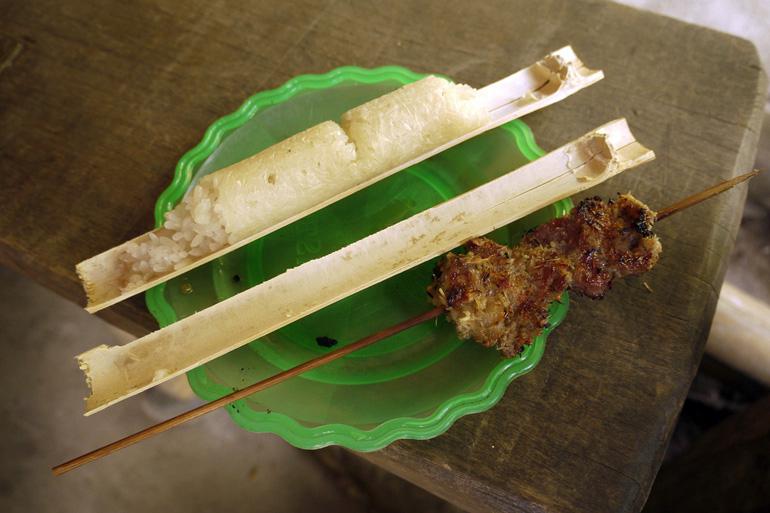 Bamboo sticky rice takes ordinary, everyday rice and turns it upside down. Think rice is a plain dish that tastes the same no matter what? Think again. This rice is actually cooked inside bamboo and it must be on your list of top foods to try in Siem Reap.
Bamboo sticky rice takes ordinary, everyday rice and turns it upside down. Think rice is a plain dish that tastes the same no matter what? Think again. This rice is actually cooked inside bamboo and it must be on your list of top foods to try in Siem Reap.
In order to make bamboo sticky rice, locals gather stalks of bamboo and thoroughly clean and cut them in to 30 centimeter long pieces. They then combine sticky rice with black eyed peas, and a pinch salt. After which the rice is tightly packed into the cleaned bamboo sections. Coconut water is added inside the shoots and finally placed on a grill to cook.
The rice is placed directly on burning coals for about an hour until it’s ready. While it’s cooking on the hot coals, it’s important to consistently rotate the bamboo to ensure even heating. Once it’s done cooking it’s time to eat, and we swear you won’t forget this delicious combination of rice, coconut water, and beans.
7-Lap Khmer
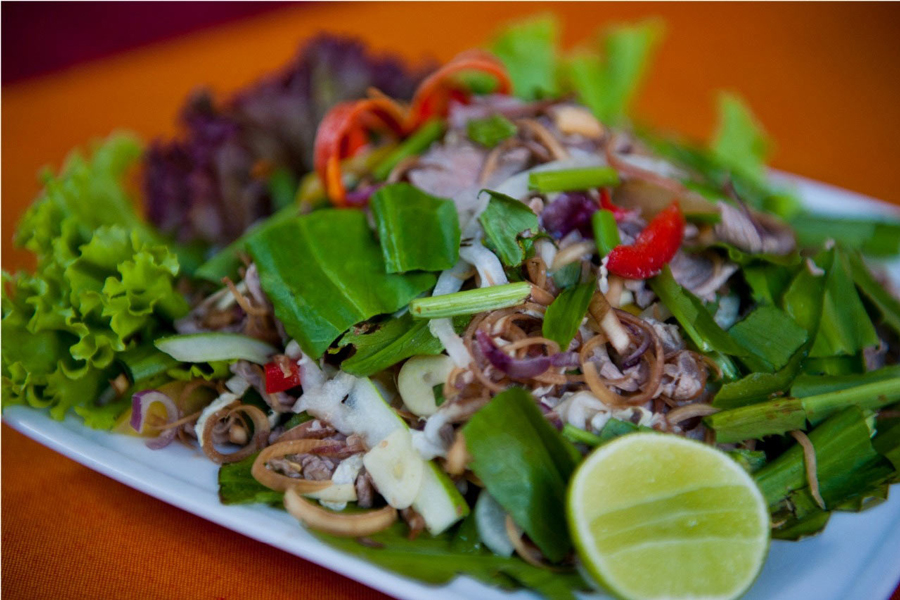 Lap Khmer is a dish reminiscent of ceviche. This lime-marinated beef salad is a Khmer staple food that is an absolute must-try in Siem Reap. Lap Khmer utilizes two main ingredients and that is raw beef slices and fresh lime juice. Lemongrass, shallots, fish sauce, basil, mint, garlic, green pepper, and green beans are also used to marinate the beef and create a salad-like dish.
Lap Khmer is a dish reminiscent of ceviche. This lime-marinated beef salad is a Khmer staple food that is an absolute must-try in Siem Reap. Lap Khmer utilizes two main ingredients and that is raw beef slices and fresh lime juice. Lemongrass, shallots, fish sauce, basil, mint, garlic, green pepper, and green beans are also used to marinate the beef and create a salad-like dish.
You’ll often find Lap Khmer served next to a bed of rice. It’s also common to eat it with fresh chilies. This is especially tasty for those who prefer a touch of spiciness to their meal. And while Lap Khmer is traditionally served with raw beef, there are many restaurants who’ll use grilled beef instead to appeal to international travelers.
No matter which way you want to enjoy Lap Khmer is up to you, just make sure you have a bite while in Siem Reap!
8-Khmer Cakes
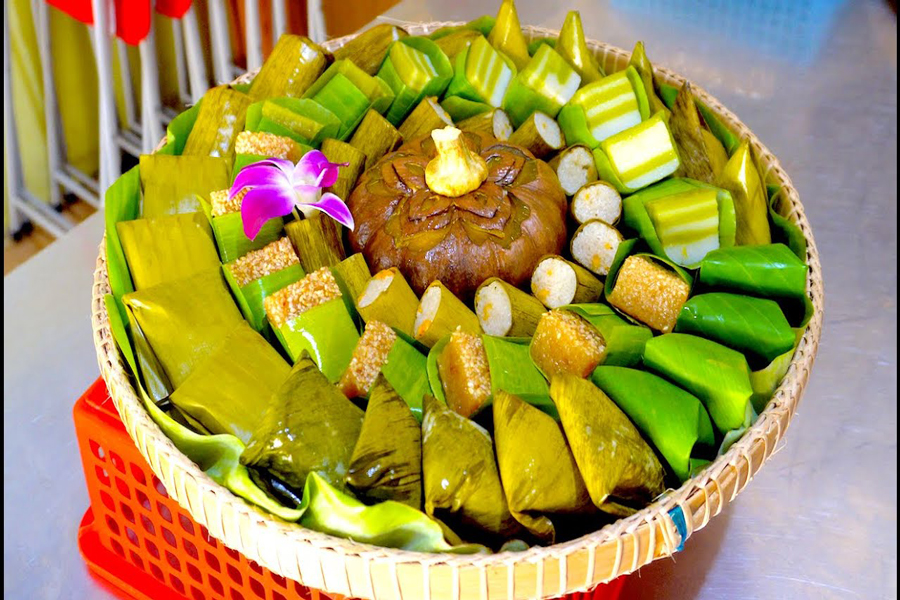 Khmer Cakes are the ultimate combination of sweet and savory. These delicious cakes are made from mung beans, taro, and topped off with with bits of fruit preserves for an added touch of sweetness. Khmer Cakes are not only loved by locals, but visitors to Siem Reap say they’re a perfect balance of sweetness that can’t be missed.
Khmer Cakes are the ultimate combination of sweet and savory. These delicious cakes are made from mung beans, taro, and topped off with with bits of fruit preserves for an added touch of sweetness. Khmer Cakes are not only loved by locals, but visitors to Siem Reap say they’re a perfect balance of sweetness that can’t be missed.
Upon taking your first bite of a Khmer Cake you mouth will be filled with the taste of sweet, slightly crunchy dried fruits on top. Followed by the soft inside filled with delicious taro and mung beans. One bite of this popular cake and you won’t be able to stop eating!
9-Khmer Red Curry
 Surprisingly Khmer red curry is not made with any chillies. This makes it great for those wanting to enjoy curry in Siem Reap without the spiciness. The color of Khmer Red Curry instead comes from kroeung, a Khmer curry paste. Kroeung is made from galangal, lemongrass, lime zest, and turmeric. The kroeung is combined with coconut-milk and a few other ingredients to make Khmer Red Curry.
Surprisingly Khmer red curry is not made with any chillies. This makes it great for those wanting to enjoy curry in Siem Reap without the spiciness. The color of Khmer Red Curry instead comes from kroeung, a Khmer curry paste. Kroeung is made from galangal, lemongrass, lime zest, and turmeric. The kroeung is combined with coconut-milk and a few other ingredients to make Khmer Red Curry.
You’ll often find it served with a French baguette along with slices of meat, either beef, chicken, or fish, eggplant, potatoes, and green beans mixed in.
10-Baw Baw
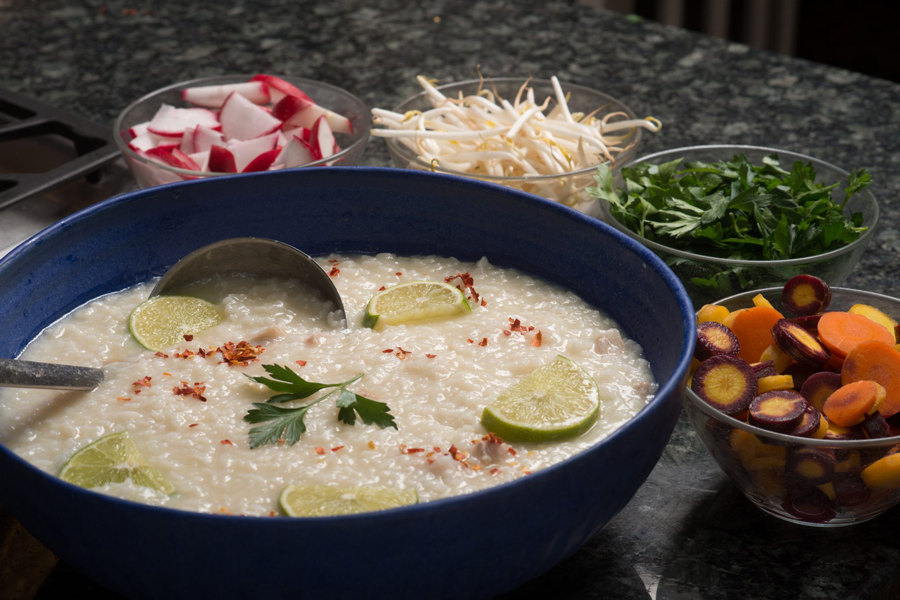 Baw Baw otherwise known as rice soup is a delightful dish packed with, you guessed it, rice and rice noodles. You’ll also find veggies and some type of protein added throughout the soup. The broth can be described as clean, but packed with flavor. It’s made with ginger, dried shrimp, and lemongrass, so it has a fairly light taste that won’t leave you bloated. Even though it’s considered a soup the consistency of Baw Baw is more like a porridge.
Baw Baw otherwise known as rice soup is a delightful dish packed with, you guessed it, rice and rice noodles. You’ll also find veggies and some type of protein added throughout the soup. The broth can be described as clean, but packed with flavor. It’s made with ginger, dried shrimp, and lemongrass, so it has a fairly light taste that won’t leave you bloated. Even though it’s considered a soup the consistency of Baw Baw is more like a porridge.
It’s known more as a comfort food in Siem Reap and also commonly eaten the winter as a hearty soup that’ll help you get over a cold. It’s typically served as a breakfast dish, but there’s no reason why you can’t try it out during a lunch or dinner break while adventuring around Siem Reap.
AsiaTourAdvisor travel agents will tell you there is never a bad time to visit Siem Reap. Which is sort of true, as long as you are flexible with how you spend your precious time once you get here. Ignore the climate stats at your peril or you could well find yourself unable to do the very things that made you want to come to Siem Reap in the first place.
 Cambodia sits slap bang in the tropics which means that the weather is warm to hot all year round and the main difference in the seasons is the amount of rain that falls. As a rule of thumb, Siem Reap is driest from November to March with hardly any rain falling in December and January, when day after day of cloudless blues skies is a regular occurrence — very handy for northern hemisphere-dwellers who need to escape the gloom of winter over that conveniently long Christmas and New Year holiday.
Cambodia sits slap bang in the tropics which means that the weather is warm to hot all year round and the main difference in the seasons is the amount of rain that falls. As a rule of thumb, Siem Reap is driest from November to March with hardly any rain falling in December and January, when day after day of cloudless blues skies is a regular occurrence — very handy for northern hemisphere-dwellers who need to escape the gloom of winter over that conveniently long Christmas and New Year holiday.
Being north of the equator — although only slightly — means that December and January are also officially winter and the coolest months of the year, bringing much relief to residents and visitors as night time temperatures can plummet to a positively chilly sub-20 degrees Celsius. Occasionally, day time highs won’t break through the 30 degree mark either. This makes it one of the best times of year for cycle rides, walking tours and visiting temples too as the heat is bearable for just that bit longer each day. Some people may disagree, but I would also rather watch the sun rise over Angkor in a clear sky than an overcast one.
I’ll take a clear sky for that sunrise, every day of the week.
If you plan on visiting the floating villages or the stilt villages on the Tonle Sap, or the waterfalls at Kbal Spean or Kulen Mountain, this is also a good time of year as the lake and rivers are still relatively full following the rainy season, and generally speaking the countryside is still lush, and the paddy fields a vibrant shade of green.
Don’t be too worried though if you are about to set for off some winter sun and hear of Cambodia being in the grip of a cold snap as it was when I arrived in Siem Reap for the first time back in 2009. Yes we saw 17C at night and one day the temperature only reached 26C but it was bliss.
Such a pleasant winter climate does have its drawbacks, however. It is very much the high season, meaning hotel rates go up, tuk tuk drivers drive a much harder bargain, it can be difficult to find a decent room, and everywhere you go — from temples to restaurants — can be very crowded. Just make sure you book as much as possible in advance, get off the beaten track and find some of the quieter temples, and read up on anger management techniques for when things don’t go quite as you would wish.
From March onwards the mercury rises steadily with temperatures in April and May regularly nudging the 40 degree-mark and often not dropping much below 30 degrees at night. Any kind of physical activity – including temple visits — is best confined to early morning and late afternoon. On the plus side, April and May usually herald the start of the rainy season with spectacular and refreshing afternoon and evening storms that cool down the humans, wash away the dust and cause everything to burst into bloom.
Such is the popularity of Angkor these days, however, that despite the heat there is no longer a notable drop in visitors in April and May, which can put a strain on the electricity grid as thousands of air conditioning units work overtime. If you do visit at this time of year and aren’t a fan of the heat, be sure to book into a hotel not only with air-con but also with a generator so you don’t end up melting in the dark should there be a power cut.
From June onwards the temperature starts to drop but the rains become more frequent. There are rarely days when it rains for more than an hour or two and is very unusual for the sun not to show its face at all. The impressive torrential downpours tend to come in the afternoons leaving much of the day free for visiting the temples and other outdoor activities. The rain can be very intense — Siem Reap receives on average as much rain in August, September and October as London does in an entire year — and occasionally flash floods do occur. Usually they are not too serious, and certainly not serious enough prevent tuk tuks from ploughing on regardless through the town’ soggy streets.
You do need to be careful walking through flood waters, however, as you can’t see what is lurking beneath — as a friend of mine discovered last rainy season when he tripped into a submerged hole on Pub Street and broke his leg.
As with pretty much anywhere, weather patterns in Siem Reap are not as reliable as they used to be. All you can really be sure of is that it will almost definitely be hot when you visit, and if you come between April and October, you stand a good chance of seeing storms so spectacular that you’ll probably be glad you didn’t follow the crowd and wait until December.
Throughout this article, we wish you to have an idea of how to travel to Siem Reap for your best experience. In case you are looking for your own travel agent, who can offer a wonderful and hassle-free trip to Siem Reap, please feel free to let us know. We always commit our best to make it your once-in-a-lifetime journey.
You may also like
Cambodia Discovery 7 Days
- Depart Time:Daily
- Starts/Ends:Phnom Penh/Siem Reap
- Tour type:Private Tours
- Travel Style:Heritage Tours, Family Tours, Culture & History
- Activities:Walking tours, Local culture tours, Cultural, religious and historic sites tours, Countryside and village visits tours
- Suitable for:Solo, Family, Group, Couple
- Age range:1 To 90 Years
- Operated in:English, French, Spanish, German, Italian
Cambodia Cities & Southern Coast 12 Days
- Depart Time:Daily
- Starts/Ends:Siem Reap /Phnom Penh
- Tour type:Private Tours
- Travel Style:Heritage Tours, Family Tours, Culture & History
- Activities:Walking tours, Local culture tours, Cultural, religious and historic sites tours, Countryside and village visits tours
- Suitable for:Solo, Family, Group, Couple
- Age range:1 To 90 Years
- Operated in:English, French, Spanish, German, Italian
Truly Cambodia 11 Days
- Depart Time:Daily
- Starts/Ends:Phnom Penh/Phnom Penh
- Tour type:Private Tours
- Travel Style:Heritage Tours, Family Tours, Culture & History
- Activities:Walking tours, Local culture tours, Cultural, religious and historic sites tours, Countryside and village visits tours
- Suitable for:Solo, Family, Group, Couple
- Age range:1 To 90 Years
- Operated in:English, French, Spanish, German, Italian
Cambdodia In Style 10 Days
- Depart Time:Daily
- Starts/Ends:Siem Reap /Phnom Penh
- Tour type:Private Tours
- Travel Style:Family Tours, Culture & History
- Activities:Walking tours, Local culture tours, Cultural, religious and historic sites tours, Countryside and village visits tours
- Suitable for:Solo, Family, Group, Couple
- Age range:1 To 90 Years
- Operated in:English, French, Spanish, German, Italian
 France
France  Spain
Spain  German
German  Italian
Italian 





 Vietnam Tours
Vietnam Tours  Cambodia Tours
Cambodia Tours  Myanmar tours
Myanmar tours  Thailand Tours
Thailand Tours  Laos Tours
Laos Tours